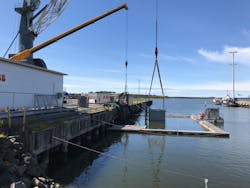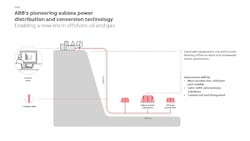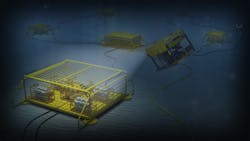Subsea power system opens way to longer-distance deepwater step-outs
ABB has completed a 3,000-hr shallow-water test of its world-first subsea power distribution and conversion technology system. All building blocks are now proven for the development, which started in 2013 under a $100-million joint industry project (JIP) supported by Equinor, Total, Chevron, and the Research Council of Norway. The main goals were to qualify the system’s capability to ensure reliable power supply of up to 100 MW, in water depths down to 3,000 m (9,842 ft), and over distances of up to 600 km (373 mi) via a single cable.
Using the new technology to power pumps, motors, gas compressors and other modules on the seafloor, closer to the reservoir, should allow operators to boost recovery rates, ABB claimed, also cutting the power consumption costs of their subsea field developments. The configuration is designed to supply power directly from the shore, if need be: analysis of a specific field development suggested potential capex savings of over $500 million if eight modules were connected via a single cable over a distance of 200 km (124 mi) from other offshore infrastructure.
Prior to the extended running test completed last November at the company’s quayside facility in Vaasa, western Finland, the transmission cable and subsea step-down transformer had already come through successful underwater trials. The fully proven subsea power distribution/conversion system includes medium-voltage switchgear and variable-speed drives (VSDs), low-voltage power distribution power electronics and controls. The distributed control system ABB Ability System 800xA was used to manage the test campaign.
Svein Vatland, Subsea Joint Industrial Project Director at ABB, said various major challenges had to be addressed from the outset of the project. “We were looking to put this equipment in locations that are hard to access. At the same time, it needed to be extremely reliable, operating for up to 30 years while on the seafloor in 300-bar [4,351-psi] pressure and water depths of up to 3,000 m.
“To ensure pressure compensation, the equipment needed to be at the same pressure inside and outside. Thermal performance was another concern, as the equipment generates heat, and we needed to get rid of that.” Other issues that had to be addressed included scaleability, materials compatibility, weight, and footprint on the seafloor.
“To get there, we had to undertake an expensive and extensive test qualification program with all equipment certified to TRL 4, meaning that it would be ready for a real offshore deployment. Along the way we established various test labs, accelerated testing procedures, including pressure and shock tests. The good thing was that ABB had been producing all the equipment for topsides applications for years, so it was a case of adapting it for subsea purposes.”
Qualification background
In a paper delivered at OTC last year*, Vatland and ABB co-presenters Stian Ingebrigtsen, Henning Nesheim, and John Pretlove described how a combination of technologies for subsea power transmission, distribution, and conversion could allow an entire oil or gas production facility to be located directly on the seafloor, thereby extending possibilities for field development in deepwater and/or remote from offshore infrastructure. The JIP’s first major milestone was set in late 2017 when the first full-scale prototype of the VSD passed a shallow water test (SWT). Attention then turned to the full-scale 3,000-hr shallow water test of the complete subsea power system in a sheltered harbor with two VSDs deployed in parallel, combined with subsea switchgear and controls. The VSDs would be capable of running a combined load up to 18 MVA, covering most identified needs for subsea power, with the power supplied from any available topside facility or directly from shore.
Main deliverables of the JIP were the subsea VSD, subsea medium voltage (MV) switchgear, subsea control and low voltage distribution, and to demonstrate to the industry that all could run without intervention for many years. All project qualification activities followed recommendations and technology readiness level (TRL) stages defined in DNV RP-A203, for components, equipment, and assemblies in offshore hydrocarbon exploration and exploitation. To ensure compact and reliable solutions, ABB selected oil-filled pressure compensated tanks for enclosure of the VSD and switchgear. All components were tested thoroughly at the full pressure they would encounter at the target water depth. One of the primary concerns was ensuring the design of the equipment minimized production downtime and the need for subsequent retrievals.
The JIP’s base case was a subsea power system with a subsea switchgear feeding four VSD loads at a water depth of 3,000 m. The API TRL4 full-scale prototypes included four-feeder subsea switchgear, two MV subsea power drives with input transformers, and a subsea control module with the subsea protection relay. Each prototype underwent various tests before launch into shallow waters at the Vaasa quayside for the final 3,000-hr high-power demonstration, which would test and confirm the thermal properties and marinization of the equipment.
Within the subsea control system there are main assemblies for power distribution, conversion, auxiliary supply and control for a ruggedized subsea electrical power supply for longer distances and deeper waters. According to ABB, it is based on field-proven, existing control solutions but still needed to be modified for qualification in a subsea environment, with a brand new enclosure design and a more advanced penetrator solution. The end-result, the company claims, provides more advanced functionality and is much more powerful than any previous subsea controllers. Use of wiring is more extensive and the new control topology will involve employing large-scale fiber optical signal distribution between subsea units. The main challenge was to qualify all the individual components and ensure they could work together as a system, including the Master Control Station and all other topside equipment used for operation, configuration, maintenance, and troubleshooting, plus validation of the associated software.
After investigating potential adaptations of existing controllers, ABB ended up combining the proven electronic circuitry and functionality of its standard ABB PEC controller with an updated and new PCBA (printed circuit board assembly) form factor and a new electronic layout. The design was subsequently altered to improve the PCBA’s dynamic response to vibration, and after comprehensive testing of single electronic boards, the next step was to test different assembly design concepts based on multiple boards to create a complete controller. These test results provided the basis for a new set of rules and guidelines for the design, layout, mechanical mounting and support of electronic boards for subsea use.
The program of intense testing and prototyping led to a reliable and stable subsea controller which, according to the company, performed beyond expectations. During the vibration testing and development of all components, all failures that came to light were shared with the project partners, drawing on their experiences to determine the potential impact of a fault. ABB also worked with its sub-suppliers to analyze the causes and to determine rectification measures, with additional stress testing undertaken that often exceeded requirements in the qualification specification, the purpose being to ensure a comfortable design margin. Once the PEC controller and the other control boards had passed the board level qualification they were assembled into a complete unit, the SEM, which also needed to be tested and qualified.
The subsea VSD is critical for controlling the speed and the torque of the subsea motors for seawater injection, boosting and compression. ABB’s base case was induction-type pump motors but in special cases, permanent magnet types could also come under consideration. The design of the subsea is fully pressure-compensated: its enclosure is oil-filled and pressure-compensated, with the hydrostatic pressure of the seawater acting on the oil to maintain the ambient pressure inside the enclosure. All power components are cooled by natural convection of the oil, with the head transferred to the surrounding seawater. In addition, the oil provides electrical insulation and meets the specifications for ABB power transformers.
A drive transformer integrated in the VSD is powered via the subsea switchgear at a supply voltage in the range 11-33 kV, at conventional 50/60 Hz or low-frequency AC 16 2/3 Hz supply frequency. The drive then converts the power to a variable-output voltage that ranges from 2.3-7.2 kV or greater. Its modular design allows it to be scaled to operate various types of subsea motors with shaft powers up to 15 MW. Two drive units operating in parallel are sufficient to power the largest seabed compressor, ABB added. Its operating frequency range is generally limited to 200 Hz, apart from 300 Hz for high-speed compressor loads below 5 MVA.
The VSD’s cell-based topology and proven power semiconductors and the built-in redundancies in its control and power circuits should minimize the need for maintenance. According to the company, any power cell failure would be prevented from spreading to neighboring cells, with the faulty bypassed by using integrated disconnectors to continue operation. Even with the loss of one cell per phase the VSD should continue providing full nominal power, and the drive redundancy fault management system is itself redundant at several levels.
ABB developed novel design solutions for packaging existing IGBT and rectifier chips to ensure compatibility with the pressure and oil environment for the subsea application. Tests included subsea-specific verifications to prove the robustness of the materials adapted for the new environment, and power cycling/thermal cycling to demonstrate that the semiconductor modules could withstand load and temperature cycles in the subsea application. The full power cell was operated over thousands of hours under pressure: all components, including the optical fibers and their connectors, performed as intended. ABB successfully tested the first subsea VSD prototype in November 2017, with results conforming fully with the JIP partners’ performance requirements. The company believes this was the first instance of a medium-voltage VSD in seawater operating at 9-12 MVA over an extended period.
The MV subsea switchgear, which is derived from established ABB vacuum breaker technologies, distributes main power to the subsea VSDs and other power consumers on the seafloor (i.e. drives for pumps or subsea compressors). It can support up to six feeders including an incoming breaker, or a tie-breaker to support two sets of switchgear. The incomer of the switchgear connects either to the output of the subsea step-down transformer, or to a subsea power cable from the platform topside or the shore. Rated phase-to-phase voltage of the switchgear is 36 kV while the main bus bar current is 1,600 A. The concept is modular and scalable, with LFAC 16 2/3 Hz power distribution said to be feasible for very long transmission distances. More typical would be four-six circuit breakers with a four-feeder configuration. The switchgear is integrated with two auxiliary step-down transformers to power the redundant auxiliary power distribution system. It also includes low-voltage miniature circuit breakers that facilitate de-energizing and independent retrieval of the connected auxiliary load, provide protection against faults in the auxiliary system, with an external power input for monitoring of system.
The switchgear has a modular and pressure-compensated design with passive oil cooling, and an MV breaker module. In a four-feeder configuration, the breaker module comprises 12 circuit-breaker poles, four fuse poles (gas-filled pressure resistant ceramic enclosures), redundant current and voltage sensors, interconnecting busbars, and copper connections integrated into a metallic frame. A ‘pole’ is a gas-filled, pressure-resistant ceramic enclosure: the circuit-breaker pole encloses a vacuum interrupter bottle and an electromagnetically driven pushrod, while the fuse poles enclose medium-voltage, expulsion-type fuses. In addition, measurement boards for current and voltage sensors are placed in redundant 1-atmosphere metallic canisters close to the sensors. Each feeder has a circuit breaker of three poles, one for each phase, capable of carrying current of 1,600 A and of interrupting any current up to 16 kA over 1 second. MV fuses at the input of each auxiliary transformer enable upstream short-circuit protection.
During the JIP project, the switchgear’s oil-immersed components were tested under cyclic and static pressure and underwent IEC /IEEE type test programs in order to qualify the sensors. Qualification of the breakers included make-and-break tests at 16⅔ Hz supply at rated short-circuit current and maximum asymmetry. ABB initially developed four separate designs of the 1-amospheric circuit breaker poles in different construction materials. The selected four-feeder breaker module prototype was assembled and tested at the company’s medium-voltage product factory in Ratingen, Germany.
For the final 3,000-hr shallow-water test, two prototype VSDs operated in parallel at full rated current, in a “power-in-the loop” setup that included the subsea switchgear prototype. This allowed power to be circulated in a back-to-back configuration via a load feedback transformer, with only the heat losses having to be supplied from the connected grid. With the support of MV load breakers located onshore, ABB was also able to test different load conditions allowing variable output frequencies (i.e. coil or motor loads).
The tank walls of the two prototype VSDs featured different cooling designs, and the drives’ thermal performance was assessed under varying loading conditions. Initially there was a thermal run to stability at nominal power, followed by both drives running at steady and cyclic load for a longer period. Other tests covered redundant communication, black-start sequences, verification of ride-through (energy storage), protection setting adjustments, fast load shedding and operation of the drives with one or more cells out-of-service. All prototype equipment and electrical infrastructure was controlled using the ABB Ability Control System 800xA.
During a panel session in Vaasa last November staged to coincide with completion of the 3,000-hr test, representatives from three of the JIP member companies gave their verdicts on the results. Kevin Kosisko, Managing Director of ABB’s Energy Industries group, said the $100-million six-year R&D project had been one of ABB’s largest-ever, involving more than 200 scientists working globally with the JIP partners. “The shallow-water test at Vaasa has proven that the subsea equipment is commercially viable and ready to deploy,” he added.
Per Gerhard Grini, Manager of Equinor’s Subsea/Topside Unit, said: “We now have proven equipment for a long step-out distance in deepwater. One of the key lessons learned from our point of view was how we managed to make ABB’s knowledge compliant with Equinor’s domain knowledge.”
Equinor has the world’s first subsea gas compressors in operation on its Åsgard and Gullfaks fields offshore Norway, but as Grini pointed out, in both cases the equipment is close to the platforms and in relatively shallow water. “Now we can go much farther out, with one power cable sufficient for the switchgear…Looking forward, the new technology is not at its limits yet: we would also like to see elimination of umbilicals, the inclusion of all-electric valves, and maybe subsea storage.” The subsea switchgear could potentially be applied in future to power offshore floating wind turbines in place of the network of cables currently used to power this equipment, Grini added.
Jeremy Cutler, Head of Total’s Research Center in Stavanger, said: “Total considers this a transformative technology, putting subsea power where we need it in place of more expensive topside VSDs and associated controls.” It could also allow the company to explore more widely in deepwater and at the same time open up more deepwater areas for lower-cost marginal field developments, he suggested. From Total’s viewpoint, subsea multiphase pumps and subsea storage of chemicals could be two of the next applications to aim for.
Although Chevron was not represented, the company is actively looking at suitable projects involving subsea pumping and compression, said ABB’s Svein Vatland. He concluded that the subsea power distribution and conversion system would be made available to all subsea operators, not solely the JIP members. •
*ABB Subsea Power JIP – Going the Distance, Offshore Technology Conference, Houston, 2019, organized by the Society of Petroleum Engineers.
About the Author
Jeremy Beckman
Editor, Europe
Jeremy Beckman has been Editor Europe, Offshore since 1992. Prior to joining Offshore he was a freelance journalist for eight years, working for a variety of electronics, computing and scientific journals in the UK. He regularly writes news columns on trends and events both in the NW Europe offshore region and globally. He also writes features on developments and technology in exploration and production.





